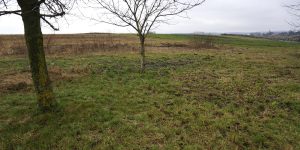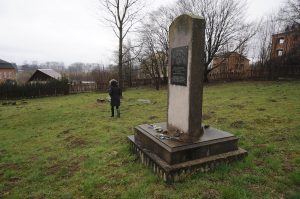
Looking south across the 1942 mass grave today, from the Soviet monument to the Jewish survivors’ and descendants’ monument. Photo © RJH.
As we try to do every year on March 20th, Jay and I traveled today to Rohatyn to honor the memory of the more than 3000 Jewish victims murdered and buried at the mass grave south of Rohatyn’s city center. This year marks 82 years since that tragic event.
![]() Ця стаття також доступна українською.
Ця стаття також доступна українською.
Joining us was our dear friend Iryna Nebesna from Ternopil with whom we have traveled the region and worked at Jewish burial sites, including in Rohatyn, and who is herself a heritage activist and journalist. Like last year, Lviv friend and colleague Alex Dunai, a professional genealogist from Lviv, provided transportation to and from Rohatyn, translations during local meetings when needed, and his usual relaxed good humor. It is always a pleasure for us to be with these dear friends, despite today’s sad occasion for the reunion.
Once at the south mass grave memorial site, we read El Malei Rachamim (אֵל מָלֵא רַחֲמִים), a prayer for the souls of the departed innocents, and then I spoke the following words on behalf of my Rohatyn-related family members and other Jewish descendants of Rohatyn who could not be here with us:
Today is a sad anniversary for all of us, regardless of whether we are children and grandchildren of Rohatyn Jewish families, or Ukrainians living today in this city which we cherish. 82 years ago, here on this open, windy hill, a human tragedy happened which affected all of us who have connections to this city. A great many people – young and old, men, women, and small children – died here under circumstances impossible to imagine.
For many Jewish families, the horrific events of March 20, 1942 at this site irreparably broke their connection to the town: they no longer consider Rohatyn a place to which they want to return. They no longer have family waiting for them here. For some Rohatyn Jewish families, the pain is still too great – even 82 years later – to consider ever making a visit to Rohatyn. But, moments such as this, when we meet – here – to remember together, help to lessen the pain, and to build bridges between the nations and the generations.
Today, Rohatyners and friends – Jewish and non-Jewish – have come together here to share in collective memory of those who suffered in this place. By our actions, we also offer solace to those living abroad and in Rohatyn today, who know what happened at this place 82 years ago. History, even tragic history, is a part of who we are, and part of what we give forward to our children. We each must believe this to be true, or we would not have come here today, at this site.
Together we keep alive the truth, and the human values which bind us together.
Baruch Dayan HaEmet.
Вічна пам’ять.
Prior to this brief service, we met with Ihor Zalypko and Vasyl Yurkiv, local Rohatyn residents who will again work for us this year cutting and clearing at the four Jewish burial sites in Rohatyn. The arrangement we initiated during the Covid-19 pandemic with these men – both of whom are neighbors to Rohatyn’s Jewish cemeteries – has proven indispensable to our ability to keep up with Mother Nature’s work at these Jewish historic sites, and we have come to depend on them to keep the sites (two cemeteries and two WWII mass graves) looking respected and cared for.
Their help is that much more important as we enter the third year of Russia’s war on Ukraine: transportation to and from Rohatyn has become more expensive and difficult for us and most of our past volunteers are either now serving in the military, out of the country, or have limited time and ability to continue helping us care for the sites. We are grateful to Ihor and Vasyl, and we have paid forward for their planned work at the sites through 2024.
Additionally, we photographed a Jewish headstone fragment recently spotted on the side of the road in the Zavoda district of Rohatyn and then recovered thanks to a heads-up message from our friend in town Tetiana Petriv, director of the Museum at the historic Holy Spirit UNESCO wooden church in Rohatyn (a part of the Prykarpattia Museum of Art group). In past years, dozens of headstones have been recovered from this area of the city. We are very grateful to Tetiana for bringing the headstone to our attention and then arranging for it to be carefully transported to the old Jewish cemetery by long-time Rohatyn friend Vasyl Myts, director of Rohatyn’s municipal landscaping and community improvement department, plus two of his employees. A translation of the fragment’s remaining inscription kindly provided by Facebook friend Gerald Pragier in Israel reads as follows:
The lady Feiga daughter of Meir, of blessed memory.
May her soul be bound in the bond of [eternal] life.

The headstone recovery in progress, from where it was discovered to the old Jewish cemetery.
Photos courtesy Tetiana Petriv.

Tetiana (at right) coordinating the recovery of Jewish headstone fragment at the Rohatyn Fire Department in 2021. Photo © RJH.
Tetiana continues to be one of our strongest local advocates and a long time supporter of our work over the last 13 years, for example joining us last year on June 6 at the north mass grave to remember the Jewish victims of the ghetto liquidation and coordinating other headstone recoveries. Tetiana’s original Facebook message regarding the discovered headstone captures her commitment and passion for the city’s multicultural prewar history and the importance to her of heritage preservation: “You have done and are doing important work. And this is a huge contribution to the preservation of history and memory. The memory must be preserved…..” Amen to that.
Finally, we spent our day in Rohatyn as we usually do, walking all four Jewish heritage sites, noting any issues that will need addressing when the weather improves, and recording the sites in photos, a few of which are included here.









